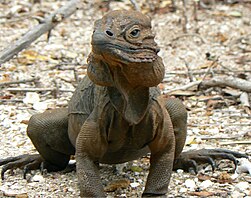 A Rhinoceros Iguana, Cyclura cornuta | ||||||||
| Scientific classification | ||||||||
|---|---|---|---|---|---|---|---|---|
| ||||||||
| Included groups | ||||||||
| ||||||||
| Excluded groups | ||||||||
|
Reptiles, or members of the class Reptilia, are air-breathing, cold-blooded vertebrates that have skin covered in scales as opposed to hair or feathers. They are tetrapods (having or having descended from vertebrates with four limbs) and amniotes, whose embryos are surrounded by an amniotic membrane. Modern reptiles inhabit every continent with the exception of Antarctica, and four living orders are currently recognized:[1]
- Crocodilia (crocodiles, gavials, caimans, and alligators): 23 species
- Sphenodontia (tuatara from New Zealand): 2 species
- Squamata (lizards, snakes, and amphisbaenids ("worm-lizards"): approximately 7,900 species
- Testudines (turtles, tortoises, and terrapins): approximately 300 species
The majority of reptile species are oviparous (egg-laying) although certain species of squamates are capable of giving live birth. This is achieved, either through ovoviviparity (egg retention), or viviparity (offspring born without use of calcified eggs). Many of the viviparous species feed their fetuses through various forms of placenta analogous to those of mammals with some providing initial care for their hatchlings. Extant reptiles range in size from a tiny gecko, Sphaerodactylus ariasae, that grows to only 1.6 cm (0.6 in), to the saltwater crocodile that may reach 5.5 m in length and weigh over 1,000 kg.
Taxonomy
Classification to order level, after Benton, 2004.[6]
- Series Amniota
- Class Synapsida
- Order Pelycosauria*
- Order Therapsida
- Class Mammalia
- Class Sauropsida
- Subclass Anapsida
- Order Testudines (turtles)
- Subclass Diapsida
- Order Araeoscelidia
- Order Younginiformes
- Infraclass Ichthyosauria
- Infraclass Lepidosauromorpha
- Superorder Sauropterygia
- Order Placodontia
- Order Nothosauroidea
- Order Plesiosauria
- Superorder Lepidosauria
- Order Sphenodontia (tuatara)
- Order Squamata (lizards & snakes)
- Superorder Sauropterygia
- Infraclass Archosauromorpha
- Order Prolacertiformes
- Division Archosauria
- Subdivision Crurotarsi
- Superorder Crocodylomorpha
- Order Crocodilia
- Order Phytosauria
- Order Rauisuchia
- Order Rynchosauria
- Superorder Crocodylomorpha
- Subdivision Avemetatarsalia
- Infradivision Ornithodira
- Order Pterosauria
- Superorder Dinosauria
- Order Saurischia
- Class Aves
- Order Ornithischia
- Order Saurischia
- Infradivision Ornithodira
- Subdivision Crurotarsi
- Subclass Anapsida
- Class Synapsida
